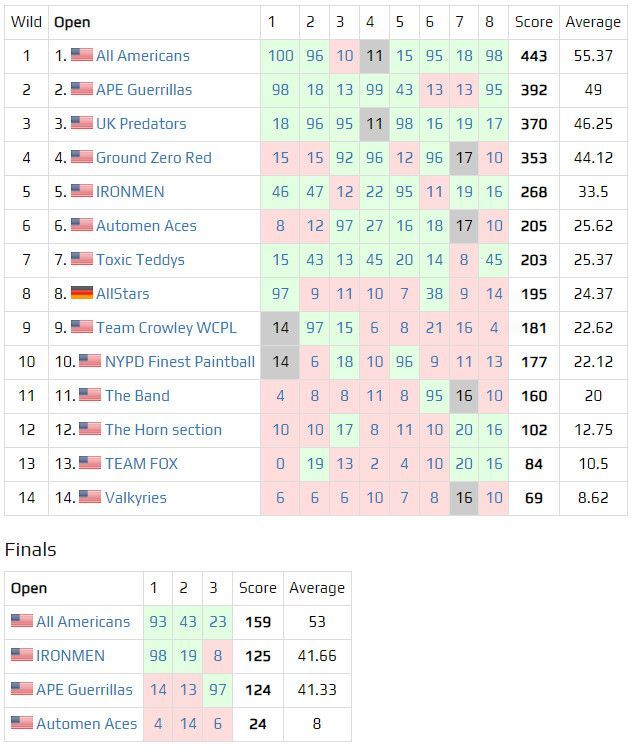Squeezing and Shortening the Game

In part 1 I covered the wide range of skills that are required for successful woodsball play. But before I go on, let me address what I mean by "successful" woodsball play.
If you and your team are learning something every game, if your game results steadily improve, if you are still focused on learning and getting better, AND if you still want to hit the field every weekend to play, that's success. I used to use the following analogy with the teams I played for and coached: if we suppose that there are 100 things that must be mastered to put a winning team on the field and you just learned a hard lesson about what not to do (or discovered that there was a better way to do something) and, if you analyzed and internalized that lesson, you've just knocked off one of those 100 things, only 99 more to go.
"Success" does not have to be displayed on the scoreboard. If you identify and check off on each of those "100 things", you and your team will eventually be winning more than you lose. It's inevitable.
But we're here talking about different forms of the game and why some people prefer woodsball, while also believing that the woodsball format requires a wider range of skills, and offers players a wider range of effective actions than other formats.
The sub-title of this piece is "Squeezing and Shortening" the game. I chose that sub-title because that is exactly what has happened over the past 40 years. That first game took place on an 80 acre field with no time limit. The game only ended when the conditions for a win were met.
Shortly thereafter, with the introduction of the team-based version of paintball, fields remained the same size (or were larger) and time limits for 20 and 15 player teams were scheduled for as long as 90 minutes. Those numbers whittled down to 15 players and an hour long game for a number of years.
Field size was again reduced when team size was dropped to 10 players, game time reducing to 25 minutes, fields reduced to a handful of acres. Then five player was introduced and game times dropped to 12 minutes, with fields getting even smaller.
When concept fields (hyperpipe, inflatables, pallets and spools) were introduced, some large fields were constructed but it was quickly realized that the lack of cover and flat ground (as opposed to variegated terrain) resulted in quick eliminations, many such fields were reduced to sizes resembling what are now referred to as "postage stamp" sized fields. Fields that you can not only see nearly every terrain feature from any location, but also fields that are small enough to let a player shoot (effectively) corner to corner across the entire field.
These changes are, in many ways, similar to the differences that are found between hunting actual game in the woods, where tracking, knowledge of the prey, knowledge of the land, is required and "hunting" ducks on a rotating wheel from behind a fairground counter. You still have to be able to aim and time the movement of your target, but all of the targets have been gathered together for you in one easily acquired position. You don't have to find the ducks before you can shoot them.
Now most of these changes were made for two reasons and two reasons only: the first is economic. The smaller your fields are and the shorter your games are, the more teams (and therefore, entry fees) you can collect for a given event. Nothing wrong with that.
An accompanying fact that should not be lost on most players is that small fields with artificial bunkers and games with short time frames also encourage the shooting of more paintballs. Shooting more rather than less always positively impacts an event's bottom line.
And, in these inflationary times, everyone should be intimately familiar with product down-sizing. If you want to lessen the customer's perception of your product, you don't increase the price. You keep the packaging the same, but reduce the contents. You used to get 2,500 balls in a case. Now there's only 2,000, even though you are still buying "a case".
Some of this may be a little abstract, at least in the ways that it affects paintball, so lets take things back to the field.
Early discussions amongst tournament operators and promoters centered on figuring out how the game could be changed so that the nearly everything but the "fight at the fifty" was eliminated. Early testing of formats that involved placing two lines of player facing each other ON the fifty did not produce appealing results. Players kind of liked picking their own locations and running to them in their own way(s). (That's a joke. But there was a lot of discussion of how to compress the game to its most exciting elements.)
Back to downsizing. If the price stays the same, something else has to give. What "gave" was team size, field size and game length. The most extreme example of this I ever saw was the Indoor event in West Virginia: 3 minute five player games on fields that were 50 feet long. Teams started with their backs to the net and they had only one direction they could go - forward into the faces of their opponents.
What was missing?
Vertical and retrograde movement. And that's a shame, because one of the funnest things you can do on the paintball field is to "run away from the other team and draw them into an ambush".
When was the last time you saw a player/team playing back-up ball? It's a well-known defensive tactic known as "trading space for time". It happens fairly frequently in woodsball. A team pushes, loses too many players and then pulls back, attempting to maneuver their opponents into less advantageous positions, attempting to whittle down the numbers facing them.
It's a fine art that takes a lot of skill to work effectively, and one that is almost entirely absent in non-woodsball play.
There are other tactics you don't see on the small, open fields either. Like shifting players from one side of the field to the other, "stacking" a side preparatory to a push. Or, one of my favorites - sneaking a player or two into a location that another one of your players then ostentatiously pulls out of. When handled correctly, the other team thinks that area of the field is now open, undefended. But when they advance....
A lot of this kind of play has become lost art, because on the small, open fields, with tight game times, there are simply no opportunities to develop that kind of play.
I'll give you another one that could be run on a concept field, but it would never work. However, in the woods, it can be devastating.
Most teams playing five player ball know (or at least used to) that there were basically three standard deployments for teams. Your opponents could either deploy, on the break, into a 2 - 1 - 2 positioning or either a left hand or right hand 2 - 3 positioning.
This gag play relies on that knowledge, shows the opponent that you are doing what they think you're doing, and then does something completely different.
On the break, your team sends two to the left, heading for the fifty and contact with the other team. Meanwhile, you send 1 player to the right side of the field, taking a concealed route to a location that offers good defensive opportunities.
Meanwhile, your remaining two players are moving down the left side of the field, concealed, and approaching the positions of your two other players who are now shooting and shouting.
Those remaining two players are waiting for the other team to call out what they have in front of them, in this case "two opponents".
As soon as they do, you know that they are thinking that you have set up in a 2-3 deployment (or maybe a 2-1-2, but that's unlikely because they've not encountered anyone shooting from the relative middle of the field.
Once they reveal that they think they know how you have deployed, your two concealed players on the left side start to push, along with the other two players who are already there.
In the vast majority of circumstances, you'll have a 4 on 2 or, at worst, a 4 on 3 situation on that side of the field, with your team having the upper hand owing to surprise.
And your one guy on the other side of the field all by himself? He's fine. Opponents on that side of the field still have no idea what they are facing, and even if they do realize that there can only be one player over there, they still have to find him. Eating up time is the only thing you are interested in from that side of the field, as your 4 on 2 push grabs the flag and/or wraps around behind the other team on the right side.
A play like that can't even begin to be contemplated on a concept field.
It's that kind of play that woodsballers live for.








